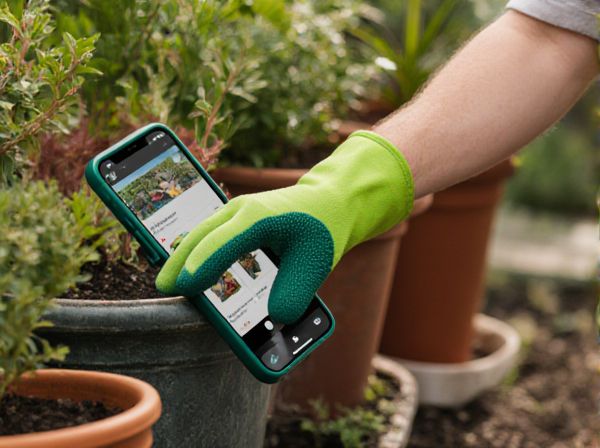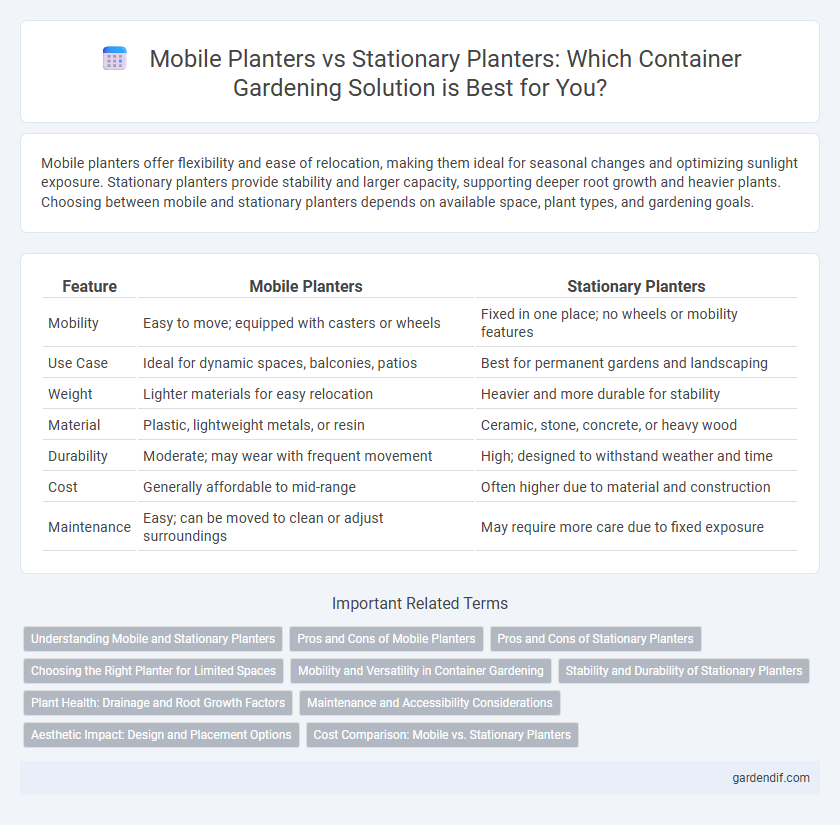
Mobile planters vs stationary planters Illustration
Mobile planters offer flexibility and ease of relocation, making them ideal for seasonal changes and optimizing sunlight exposure. Stationary planters provide stability and larger capacity, supporting deeper root growth and heavier plants. Choosing between mobile and stationary planters depends on available space, plant types, and gardening goals.
Table of Comparison
| Feature | Mobile Planters | Stationary Planters |
|---|---|---|
| Mobility | Easy to move; equipped with casters or wheels | Fixed in one place; no wheels or mobility features |
| Use Case | Ideal for dynamic spaces, balconies, patios | Best for permanent gardens and landscaping |
| Weight | Lighter materials for easy relocation | Heavier and more durable for stability |
| Material | Plastic, lightweight metals, or resin | Ceramic, stone, concrete, or heavy wood |
| Durability | Moderate; may wear with frequent movement | High; designed to withstand weather and time |
| Cost | Generally affordable to mid-range | Often higher due to material and construction |
| Maintenance | Easy; can be moved to clean or adjust surroundings | May require more care due to fixed exposure |
Understanding Mobile and Stationary Planters
Mobile planters offer flexibility for landscaping and gardening by allowing easy repositioning to optimize sunlight exposure and accommodate seasonal changes. Stationary planters provide stability and support for larger plants or trees, ensuring consistent root growth and reducing the risk of damage from movement. Both planter types serve distinct purposes, with mobile planters suited for dynamic garden designs and stationary planters ideal for permanent installations.
Pros and Cons of Mobile Planters
Mobile planters offer exceptional flexibility, allowing for easy relocation to optimize sunlight exposure, protect plants from harsh weather, or redesign outdoor spaces, which is ideal for seasonal gardening. They often come with wheels or lightweight materials, simplifying maintenance and increasing versatility, though they may lack the sturdiness and durability of stationary planters, potentially limiting their long-term use. Despite their convenience, mobile planters typically have smaller soil volumes, which can restrict root growth and require more frequent watering and care compared to stationary options.
Pros and Cons of Stationary Planters
Stationary planters provide enhanced stability and durability, making them ideal for large plants and outdoor environments exposed to wind and weather. They often offer superior water retention and better insulation for roots, contributing to healthier plant growth. However, their fixed nature limits flexibility in garden design and requires permanent placement, which can be a disadvantage for seasonal changes or space optimization.
Choosing the Right Planter for Limited Spaces
Mobile planters offer flexibility and ease of movement, making them ideal for limited spaces where versatility is essential. Stationary planters provide stability and a permanent location, suitable for maximizing vertical or fixed areas such as balconies or patios. Selecting the right planter depends on space constraints, mobility needs, and the type of plants being grown to optimize growth and accessibility in confined environments.
Mobility and Versatility in Container Gardening
Mobile planters offer superior mobility, making them ideal for adapting to changing sunlight patterns and seasonal shifts in container gardening. Their versatility allows easy relocation to optimize plant health and garden aesthetics across various spaces, unlike stationary planters which remain fixed and limit flexibility. This mobility advantage supports dynamic garden designs and enhances plant care efficiency in urban and small-space environments.
Stability and Durability of Stationary Planters
Stationary planters offer superior stability due to their fixed position and heavier materials such as concrete, ceramic, or stone, minimizing the risk of tipping or shifting in windy conditions. Their durable construction withstands harsh weather elements, exposure to moisture, and temperature fluctuations better than mobile planters. This long-lasting resilience makes stationary planters ideal for permanent garden installations where structural integrity and minimal maintenance are priorities.
Plant Health: Drainage and Root Growth Factors
Mobile planters offer enhanced plant health by providing superior drainage options, preventing waterlogging and root rot. Their mobility allows for repositioning to optimize sunlight exposure and airflow, which promotes healthier root systems and prevents disease. Stationary planters may have limited drainage efficiency and restrict root expansion, potentially leading to stunted growth and poor aeration.
Maintenance and Accessibility Considerations
Mobile planters offer enhanced accessibility for maintenance tasks such as watering, pruning, and repositioning to optimize sunlight exposure, making them ideal for seasonal plant care or limited spaces. Stationary planters, while often sturdier and larger, require fixed placement that can complicate access to certain plants and increase the effort needed for routine upkeep. Choosing between mobile and stationary planters depends on balancing ease of maintenance with space constraints and desired plant mobility.
Aesthetic Impact: Design and Placement Options
Mobile planters offer versatile placement options, allowing users to easily change the aesthetic arrangement of outdoor and indoor spaces, enhancing visual interest through flexible design adaptability. Stationary planters, often designed with more substantial materials and integrated styles, provide a stable and permanent focal point that anchors garden layouts with consistent aesthetic appeal. Both options cater to different design needs, with mobile planters adding dynamic spatial flow and stationary planters delivering enduring structural elegance.
Cost Comparison: Mobile vs. Stationary Planters
Mobile planters typically incur higher initial costs due to added features like wheels and reinforced frames designed for mobility, whereas stationary planters are generally more affordable with simpler construction. Over time, maintenance expenses may increase for mobile planters because of the wear and tear on moving components, while stationary planters often require minimal upkeep. Choosing between mobile and stationary planters involves balancing upfront investment with long-term maintenance and usability based on specific gardening needs.
Mobile planters vs stationary planters Infographic

 gardendif.com
gardendif.com